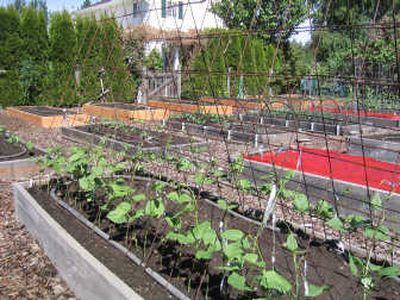Give your veggies a support network

One of the secrets to growing a lot of vegetables in a small space is using plant supports to grow them vertically.
Certain veggies – tomatoes, pole beans and peas – require some type of support in order to produce well and be easy to reach. If you let your tomato plants sprawl on the ground, for example, they’ll grow into a tangled mess and won’t produce well because they need good air circulation. In the past, there haven’t been many types of plant supports available; garden centers and mail-order catalogs now offer all sorts of cool ones.
I’ve learned to avoid buying those small, flimsy tomato cages. They fall over once the plants get top-heavy and will drive you crazy. I recently spotted sturdier tomato cages at a local garden center that are painted in fun colors such as orange, yellow and purple. For years, I’ve used 48-inch-tall cages created from leftover field fence. They are incredibly sturdy and the openings in the wire are perfect for reaching through. This year, however, I’m experimenting with spiral supports that are painted in rainbow colors. I’ve also seen coil supports in bright colors and tomato ladders that come in red or green. Who says you can’t have a little fun out in the garden?
For beans and peas, I make tent-shaped supports from two 4-by-8-foot sections of concrete-reinforcing wire that are wired together at the top and spread apart at the bottom. Depending on their height, plants can grow up one side and down the other. Even better are towers or teepee supports that are about 6 feet high. Rather than letting cucumber plants run along the ground, why not save space by growing them up one of the supports mentioned above? The same can be done with melons and vining squash plants, provided you make little slings for the fruits to be cradled in while they’re growing. If nothing else, they’ll make a good conversation piece.
In addition to providing support, the spacing of plants is crucial. I cram a lot of plants into my raised beds, but there’s a fine line between squeezing them together and still getting good production. The idea is to provide them with enough nutrients during the growing season so they thrive.
Here are some suggestions on the spacing you can get away with for commonly grown vegetables. Peas and pole beans can be spaced a mere 3 inches apart, while bush beans need 6 inches. Seed potatoes should be spaced 1 foot apart within a row and about 18 inches between rows. Peppers can manage with 8 inches of space. Broccoli and cantaloupes need about 18 inches of space in all directions, or less if you plant them in a zigzag pattern. Tomatoes and summer squash should be planted about 2 feet apart.
Be diligent about thinning certain vegetables for best results. Four crops that are especially dependent upon being thinned are lettuce, onions, carrots and parsnips.
Lettuce plants should have about 6 inches between them to keep the leaves from rotting and making a cozy little home for insects, such as earwigs, to hide in. Onions get planted about 3 inches apart but can be harvested as scallions during the season by pulling every other plant. This provides needed space for the remaining onions to form large bulbs by the end of the season. Carrots and parsnips need enough room to allow their roots to develop properly. They should be thinned to 3 to 4 inches apart in all directions.